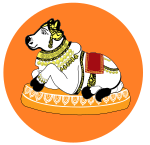Kapalika
The Kāpālika tradition was a non-Puranic form of Shaivism in India.[1] The word Kāpālikas is derived from kapāla meaning "skull", and Kāpālikas means the "skull-men". The Kāpālikas traditionally carried a skull-topped trident (khatvanga) and an empty skull as a begging bowl.[1] Other attributes associated with Kāpālikas were that they smeared their body with ashes from the cremation ground, revered the fierce Bhairava form of Shiva,[2] and engaged in rituals with blood, meat, alcohol, and sexual fluids.[1]
| Part of a series on |
| Shaivism |
|---|
 |
|
Scriptures and texts
|
|
Philosophy
|
|
Practices |
|
Schools
Saiddhantika Non - Saiddhantika
|
|
Related
|
According to David Lorenzen, there is a paucity of primary sources on Kapalikas, and historical information about them is available from fictional works and other traditions who disparage them.[3] Various Indian texts claim that the Kāpālika drank liquor freely, both for ritual and as a matter of habit.[4] The Chinese pilgrim to India in the 7th century, Hsuan Tsang, in his memoir on what is now northwest Pakistan, wrote about Buddhists living with naked ascetics who cover themselves with ashes and wore bone wreathes on their heads, but Hsuan Tsang does not call them Kapalikas or any particular name. Scholars have interpreted these ascetics variously as Digambara Jains, Pashupatas and Kapalikas.[5]
The Kāpālikas were more of a monastic order, states Lorenzen, and not a sect with a textual doctrine.[6] The Kāpālika tradition gave rise to the Kulamārga, a category of tantric Shaivism which preserves some of the distinctive features of the Kāpālika tradition.[7] Some of Kāpālika Shaiva practices are found in Vajrayana Buddhism, and scholars disagree on who influenced whom.[8] Today the Kapalika tradition has merged with Natha order, where it is practiced with the Kaula rituals.
Literature
Dyczkowski (1988: p. 26) holds that Hāla's Prakrit literature poem, the Gaha Sattasai, is one of the first extant literary references to a kapalika:
One of the earliest references to a Kāpālika is found in Hāla's Prakrit poem, the Gāthāsaptaśati (third to fifth century A.D.) in a verse in which the poet describes a young female Kāpālikā who besmears herself with ashes from the funeral pyre of her lover. Varāhamihira (c500-575) refer more than once to the Kāpālikas thus clearly establishing their existence in the sixth century. Indeed, from this time onwards references to Kāpālika ascetics become fairly commonplace in Sanskrit ...[9]
See also
References
- Gavin Flood (2008). The Blackwell Companion to Hinduism. John Wiley & Sons. pp. 212–213. ISBN 978-0-470-99868-7.
- David N. Lorenzen (1972). The Kāpālikas and Kālāmukhas: Two Lost Śaivite Sects. University of California Press. p. 4. ISBN 978-0-520-01842-6.
- David N. Lorenzen (1972). The Kāpālikas and Kālāmukhas: Two Lost Śaivite Sects. University of California Press. p. xii. ISBN 978-0-520-01842-6.
- David N. Lorenzen (1972). The Kāpālikas and Kālāmukhas: Two Lost Śaivite Sects. University of California Press. p. 5. ISBN 978-0-520-01842-6.
- David N. Lorenzen (1972). The Kāpālikas and Kālāmukhas: Two Lost Śaivite Sects. University of California Press. pp. 15–16. ISBN 978-0-520-01842-6.
- David N. Lorenzen (1972). The Kāpālikas and Kālāmukhas: Two Lost Śaivite Sects. University of California Press. p. xi. ISBN 978-0-520-01842-6.
- Sanderson, Alexis. "The Śaiva Literature." Archived 4 March 2016 at the Wayback Machine Journal of Indological Studies (Kyoto), Nos. 24 & 25 (2012–2013), 2014, pp.4-5, 11, 57.
- Ronald Davidson (2002), Indian Esoteric Buddhism, Columbia University Press. pages 202-218
- Dyczkowski, Mark S. G. (1988). The canon of the Śaivāgama and The Kubjikā Tantras of the western Kaula tradition. SUNY series in Kashmir Śaivism. SUNY Press. ISBN 0-88706-494-9, ISBN 978-0-88706-494-4 Source: (accessed: Thursday February 4, 2010)
- Dictionary of Hindu Lore and Legend (ISBN 0-500-51088-1) by Anna L. Dallapiccola (London : Thames & Hudson, 2002).
- Kapalikas and Kalamukhas: Two Lost Saivite Sects (ISBN 0-520-01842-7) by David N. Lorenzen (Berkeley : University of California Press, 1972).
- Mattavilasaprahasana by Māni Mādhava Chākyār
- Ankalaparamecuvari : a goddess of Tamilnadu, her myths and cult (ISBN 3-515-04702-6) by Eveline Meyer (Stuttgart : Steiner Verlag Wiesbaden GMBH, 1986)
- The Blackwell Companion to Hinduism. by Gavin Flood. 2003. Malden: Blackwell.
- Indian Esoteric Buddhism. by Ronald Davidson. 2002. Columbia University Press.